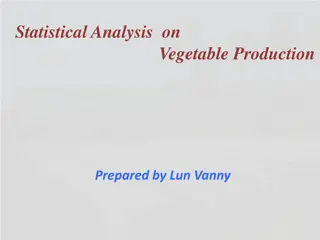
Enhancing SQLite Performance with X-FTL Transactional Solution
This paper introduces X-FTL, a transactional solution for SQLite databases aimed at improving performance in smartphone applications. It addresses the slow performance caused by SQLite's journaling modes and offers a solution for flash-aware atomic propagation. By implementing X-FTL, significant speedups can be achieved with minimal changes to existing systems, benefiting SQLite and ext4 file systems.
Download Presentation

Please find below an Image/Link to download the presentation.
The content on the website is provided AS IS for your information and personal use only. It may not be sold, licensed, or shared on other websites without obtaining consent from the author. If you encounter any issues during the download, it is possible that the publisher has removed the file from their server.
You are allowed to download the files provided on this website for personal or commercial use, subject to the condition that they are used lawfully. All files are the property of their respective owners.
The content on the website is provided AS IS for your information and personal use only. It may not be sold, licensed, or shared on other websites without obtaining consent from the author.
E N D
Presentation Transcript
X-FTL: Transactional FTL for SQLite Databases Woon-Hak Kang, Sang-Won Lee, Bongki Moon, Gi-Hwan Oh, and Changwoo Min 1
Outline Introduction Motivation Problem definition Flash characteristics and opportunities X-FTL for SQLite databases Architecture and implementation Performance evaluation Conclusion 3/18/2025 2
Introduction (1/3) SQLite is the standard database for smartphones Google Android, Apple iOS Almost every apps uses SQLite Why SQLite? Development productivity Solid transactional support Lightweight runtime footprint SQLite takes a simpler but costlier journaling approach to transactional atomicity 3/18/2025 3
Introduction (2/3) Two journaling modes in SQLite Rollback journal mode (RBJ) Write ahead logging (WAL) ( Aries-style physiological WAL) SQLite journaling mode is the main cause of slow performance in smartphone applications Kim [USENIX FAST12], Lee [ACM EMSOFT 12] 70% of all write requests are from SQLite and mostly random eMMC flash card is the default storage in smartphones SQLite optimization is the practical and critical problem We propose a transactional FTL for SQLite, X-FTL 3/18/2025 4
Introduction (3/3):Contributions Identify a performance problem in SQLite and its causes Develop new solution for flash-aware atomic propagation Implement X-FTL using OpenSSD platform Extend the storage interface for transactional atomicity Demonstrate SQLite and ext4 file system can benefit from X-FTL with only minimal changes in their code Show that 2 and more speedup can be achieved in SQLite 3/18/2025 5
Outline Introduction Motivation Problem definition Flash characteristics and opportunities X-FTL for SQLite databases Architecture and implementation Performance evaluation Conclusion 3/18/2025 6
Transactional Atomicity in SQLite (1/5) A transaction updates one or more pages {P1, ..., Pn} Steal and force policies are taken in SQLite Atomic propagation of updated page(s) by TXs is crucial for commit, abort, and recovery in SQLite 3/18/2025 7
Transactional Atomicity in SQLite (2/5) For example, two pages (P1,P2) are updated by a transaction Transactional atomicity is all or nothing Force policy need to write both pages at commit (ALL) Steal policy allows to overwrite P1 prior to commit so that we need to undo P1 s write upon abort (NOTHING) Recovery from crash checks whether both pages are successfully written, and if not, need to undo (ALL or NOTHING) Transaction commit P2_old P2_new P2_new P1_old P1_new P1_new RAM Transaction abort Recovery from crash Steal need to undo P1 s write Storage P1_old P2_old 3/18/2025 8
Transactional Atomicity in SQLite (3/5) Two journal modes Rollback journal (RBJ, default) and Write Ahead Logging(WAL) Why SQLite s own journaling modes, instead of file system journaling? Portability : every file system does not support journaling Steal policy semantics RAM P1_new P2_new Storage Journal File (Rollback/WAL) P1_old P2_old 3/18/2025 9
Transactional Atomicity in SQLite (4/5) Rollback Journal (RBJ) Old page images are backed up in RBJ file for undo RBJ file should be deleted at commit time Transaction commit is regarded as success only after RBJ file is deleted Run-time overhead RBJ file creation/deletion 3 fsync() operations per transaction Two writes per each update page A logical update can cause 22 physical page writes [Lee and Won 12] Rollback Mode Database File Rollback File File Creation TX Begin P1_old Write(P1) ... ... Write(Pn) Pn_old Commit fsync() Transaction Commit RAM P2_old P2_new P1_old P1_new Journal Header before Update fsync() P1_new fsync() DB file ... 2 fsync()s RBJ file Pn_new Storage fsync() File Deletion P1_old P2_old Journal file is deleted - TX Completion - 3/18/2025 10 RBJ file (per TX)
Transactional Atomicity in SQLite (5/5) Write Ahead Logging (WAL) Recently introduced, and better performance than RBJ WAL file is reused and shared by many transactions New page images are appended to WAL file for redo Check-point when it becomes full No file creation/deletion overhead less frequent fsync() But, 2X writes per each updated page WAL Mode Database File WAL File ... P1_new ... Pn_new RAM Transaction Commit P2_old P2_new P1_old P1_new fsync() - TX Completion - ... after Update WAL File full fsync() DB file Commit Done fsync() WAL file Check point FULL P1 Storage Checkpoint ... P1_old P2_new P1_new P2_old Pn fsync() 3/18/2025 11 WAL file
Flash Characteristics and Opportunities (1/2) In-place update is not allowed in flash memory FTLs take Copy-on-Write (CoW) strategy Both old and new copy of a page co-exist But, current FTLs change L2P address mapping at the granularity of page, not a set of pages Can not support atomic propagation of multiple pages LPN PPN P1-> New Page P2-> Old Page ... ... P1 Page Mapping Table P2 TX s update set = {P1, P2} ... ... Pn ... ... P1 ... P2 Pn P1 P2 Flash Chips 3/18/2025 12 Old copy of P1, , Pn
Flash Characteristics and Opportunities (2/2) The net effect of CoW resembles shadow paging [Lorie 77] CoW strategy provides an opportunity for transactional atomicity What if FTL can support the atomic remapping of multiple page updates by one TX? FTL need to provide transactional interface to the upper layer For undo, old pages should be exempt from GC until TX commit LPN PPN TX s update set = {P1, P2, ..., Pn} ... ... Page Mapping Table P1 Atomic remapping!! ... ... Pn New mapping ... ... Old mapping P1 ... P2 Pn P1 Pn P2 Flash Chips 3/18/2025 13 New copy of P1, , Pn Old copy of P1, , Pn
Outline Introduction Motivation Problem definition Flash characteristics and opportunities X-FTL for SQLite databases Architecture and implementation Performance evaluation Conclusion 3/18/2025 14
X-FTL: Architecture (1/2) X-FTL : Inside SSD Transactional mapping table : X-L2P table Page mapping table : L2P table (original FTL) Transaction ID, Logical Page No, Physical Page No(new), Status Garbage collection Prevent active transaction pages from GC Only pages invalidated by committed transactions Atomic propagation of mapping information at commit Atomic remapping of committed entries in X-L2P table to L2P table - Storage Interface Read(Ti, Pi) , Write (Ti, Pi), Commit(Ti), Abort(Ti) Page Mapping Table (L2P) X-FTL Transactional Write/ Read Page Mapping Table (X-L2P) LPN PPN : P1 : Pn : TID : Ti : Ti : LPN : P1 : Pn : PPNnew Status : Active : Active : : Commit/ Abort Traditional FTL with Garbage Collection Propagation at commit : : Recovery Pn Pn P2 P1 P2 P1 New copy of P1, , Pn Old copy of P1, , Pn
X-FTL: Architecture (2/2) Extend storage API (SATA interface) Transaction ID is passed to storage with Read/Write command Add Commit/Abort command Update P1, P2, , Pn, Commit/Abort Application SQLite - fsync, ioctl(abort) File System Interface Read(Pi), Write(Pi), File System - Read(Ti, Pi) , Write (Ti, Pi), Storage Interface Commit(Ti), Abort(Ti) Page Mapping Table (L2P) X-FTL Transactional Write/ Read Page Mapping Table (X-L2P) LPN PPN : P1 : Pn : TID : Ti : Ti : LPN : P1 : Pn : PPNnew Status : Active : Active : : Commit/ Abort Traditional FTL with Garbage Collection Propagation at commit : : Recovery Pn Pn P2 P1 P2 P1 New copy of P1, , Pn Old copy of P1, , Pn
X-FTL: Implementation (1/2) Changes made in SQLite ( < 50 lines) Journal mode off Commit = fsync, Abort = ioctl(ABORT) Support abort transaction in journal mode off Changes made in File system ( < 200 lines) Use extended SATA command Translate read(P)/write(P) to read(t,P)/write(t,P) Transfer commit/abort to the storage Transaction ID management per file Changes made in FTL firmware ( < 500 lines) Implement X-FTL on the OpenSSD platform Add X-FTL feature to Greedy FTL(page mapping FTL) Maintain X-L2P table Handle extended SATA command Atomic remapping/Garbage Collection/Recovery 3/18/2025 17
X-FTL: Implementation (2/2) Commit Procedure in X-FTL Storage Interface commit(Ti) return success X-L2P L2P LPN PPN : P1 : Pn : TID LPN PPNnew Status 1. Change the status of Ti s entries in X-L2P table to Committed. : .. : .. : : : : : 4. Remap LPNs updated by Ti with new PPNs Ti P1 .. Active Committed : : : : Ti Pn .. Active Committed : : : : DRAM X-L2P Address 3. Update the location of X-L2P table in flash meta-block 2. Flush X-L2P table to new location in flash X-L2P Address Address X-L2P X-L2P Table (new) Flash Chips X-L2P Table (old) 3/18/2025 18
Transactional Atomicity in X-FTL X-FTL vs. RBJ vs. WAL fsync count Write count 3 fsyncs per tx - 2 syncs for journal - 1 sync for db 1 page write -> 2x page writes RBJ 1 per tx and 1 per checkpoint - 1 sync for journal - 1 sync for db when checkpoint 1 page write -> 2x page writes WAL 1 per tx - 1 sync for db 1 page write -> 1 page write X-FTL Transaction commit P2_old P2_new P1_old P1_new RAM fsync to DB file Commit done Storage with X-FTL P1_old P2_old 3/18/2025 19
Outline Introduction Motivation Problem definition Flash characteristics and opportunities X-FTL for SQLite databases Architecture and implementation Performance evaluation Conclusion 3/18/2025 20
Performance Evaluation (1/4) Evaluation setup OpenSSD development platform : MLC NAND : Samsung K9LCG08U1M Page size : 8KB, Block : 128 pages 87.5 MHz ARM, 96KB SRAM, 64MB DRAM Linux ext4 file system (kernel 3.5.2) Intel core i7-860 2.8GHz and 2GB DDR3 SQLite 3.7.10 Workloads Synthetic TPC-H partsupply table, random update, adjust transaction length Android smartphone SQL trace using Android emulator, RL bench, Gmail, Facebook, web browser Database TPC-C (DBT2), read intensive, TPC-C original File system benchmark Flexible I/O(FIO), random write, adjust fsync frequency http://www.openssd-project.org 3/18/2025 21
Performance Evaluation (2/4) Synthetic workloads TPC-H partsupply table (60,000 tuples, 220 bytes tuple) Random update, 1-20 page updated in a tx 600 500 Execution time (sec) 400 3.0x 300 RBJ 11.7x WAL 200 X-FTL 100 0 0 5 10 15 20 # of updated pages per transaction 3/18/2025 22
Performance Evaluation (3/4) Synthetic workloads Write count (x1,000) Garbage collection count 350 1200 Thousands RBJ RBJ 1072 289 300 WAL WAL 1000 X-FTL 244 250 X-FTL 756 800 203 200 600 150 465 420 409 400 94 93 100 63 199 173 200 40 50 33 115 31 98 0 0 30% 50% 70% 30% 50% 70% GC Valid Page Ratio GC Valid Page Ratio I/O activities inside OpenSSD (# of updated pages per transaction = 5) 3/18/2025 23
Performance Evaluation (4/4) File system benchmark using FIO : random write test X-FTL transaction : data and metadata pages Linux ext4 file system journaling Data (full) : data and metadata pages Ordered (default) : metadata only X-FTL provides the same consistency level of data journaling, better performance than ordered journaling FIO : OpenSSD (single thread) 400 350 300 250 IOPS 200 X-FTL 150 Ordered 100 Data (full) 50 0 0 5 # of updated pages per fsync 10 15 20 3/18/2025 24
Outline Introduction Motivation Problem definition Flash characteristics and opportunities X-FTL for SQLite databases Architecture and implementation Performance evaluation Conclusion 3/18/2025 25
Conclusion X-FTL: Transactional FTL for SQLite databases Offload the transactional atomicity semantics from SQLite to flash storage Leverage the copy-on-write strategy in modern FTLs Achieve the transactional atomicity almost for free Halves writes and doubles the lifetime 2 ~ 3x times faster than costly journaling schemes Turn the weakness of flash memory (no in-place update) into a strong point (inherently atomic propagation of changes) 3/18/2025 26
Q & A 3/18/2025 27
Why SQLite Performs so Poor? 1 update invokes write 22 pages Length(sectors) LBA SQLite journal FS journaling SQLite Database(fb.db) Figure from Smart Layers and Dumb Result: IO Characterization of an Android-Based Smartphone [Lee and Won, 2012] 3/18/2025
X-FTL: simplified architecture Each layer do their best! Eliminate overhead Storage understand transactional semantic Extended Storage API Application Application Update P1, Pn, Commit/Abort Update P1, Pn, Commit/Abort DB Journaling SQLite DB Journaling SQLite fsync, ioctl(abort) File system File system Read(Pi), Write(Pi) Read(Pi), Write(Pi) Linux EXT4 FS Journaling Linux EXT4 FS Journaling Commit(Ti), Abort(Ti) Flash Storage Flash Storage Read(Pi) , Write (Pi) Read(Ti, Pi) , Write (Ti, Pi) CoW CoW + Atomic remapping X-FTL Log-based FTL 3/18/2025 29
Performance Evaluation : Android SQL trace using Android SDK 3/18/2025 30
Performance Evaluation : Recovery SQLite recovery Sudden Power Off Recovery (SPOR) Test Recovery time : restart times from crash File system consistency test Running FIO then SPOR test Consistency check using fsck in Linux Always pass whole stages (never report an error) mode Rollback WAL X-FTL (msec) 20.1 153.0 3.5 SQLite Restart Time 3/18/2025 31






















